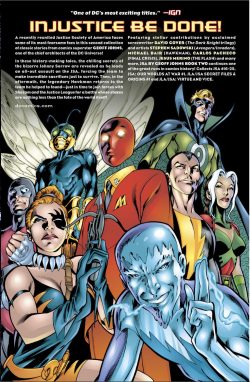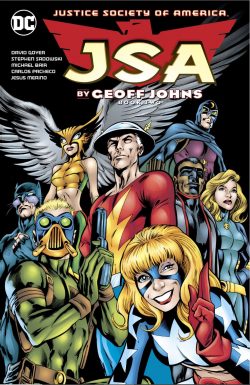

By Geoff Johns, David S. Goyer, Stephen Sadowski, Michael Bair, Carlos Pacheco, Jesus Merino, Phil Winslade, Mike Perkins, Steve Yeowell, Keith Champagne, Buzz, Rags Morales, Dave Meikis, Paul Neary, Rob Leigh, Javier Saltares, Ray Kryssing, Andrew Pepoy & various (DC Comics)
ISBN: 978-1-4012-8154-0 (TPB/Digital edition)
Win’s Christmas Gift Recommendation: Pure Perfection for Superhero Connoisseurs… 9/10
After the actual invention of the comic book superhero – for which read the creation of Superman in 1938 – the most significant event in the genre, and indeed industry’s progress, was the combination of individual sales-points into a group. Thus, what seems blindingly obvious to us with the benefit of four-colour hindsight was proven – a number of popular characters could multiply readership by combining forces and readerships. Plus of course, a whole bunch of superheroes is a lot cooler than just one – or even one and a sidekick.
The Justice Society of America was created in the third issue of All-Star Comics (Winter 1940/1941), an anthology title featuring established characters from various All-American Comics publications, by the simple expedient of having the heroes gather around a table and tell each other their latest adventure. From this low-key collaboration, it wasn’t long before the guys – and they were all white guys (except the original Red Tornado, who only pretended to be one) until Wonder Woman premiered in the eighth issue – regularly joined forces to defeat the greatest villains and social ills of their generation.
Within months the concept had spread far and wide…
And thus, the Justice Society of America is rightly revered as a true landmark in the development of comics and, when Julius Schwartz revived the superhero genre in the late 1950s, a key moment would come with the inevitable teaming of the reconfigured mystery men into a Justice League of America.
From there it wasn’t long until the original and genuine returned. Since then we’ve enjoyed many attempts to formally revive the team’s fortunes but it wasn’t until 1999, on the back of both the highly successful revamping of the JLA by Grant Morrison & Howard Porter and the seminal but critically favoured new Starman by Golden Age devotee James Robinson, that the multi-generational team found a concept and fan-base big enough to support them.
It didn’t hurt that the writers – all with strong Hollywood connections – adored the original concept, but also knew what mass-market action audiences liked. And now that the JSA have cracked the large and small screen markets, my cup – at least – truly runneth over…
Their highly successful revival began as the last survivors of the original team reconvened after losing most of their membership to old age, infirmity or enemy action. Following the death of founding comrade Wesley Dodds/The Sandman, Wildcat, Flash and Green Lantern/Sentinel united with youthful inheritors of the old team’s legacy. These included members’ children and former Infinity Inc members Atom Smasher, Obsidian and Hourman, Dodds’ sidekick Sand, Stargirl (then called Star Spangled Kid), the third Dr. Mid-Nite, Starman and Mister Terrific plus new Hawkgirl Kendra Saunders, Black Canary and Wonder Woman (in actuality, her mother Hippolyta who was an active Nazi crusher during WWII).They all united to rescue three babies; one of which became the next incarnation of magical hero Doctor Fate. Once they were successful most of the squad stuck together to continue the traditions and train a new generation of heroes…
Shortly thereafter, as old guard Flash, Sentinel and Wildcat assumed the role of mentors for both current and future champions, the multi-generational unit was attacked by demented super-human (and current Man of the Moment) Black Adam: a magically empowered superman, who usually harassed agents of do-gooding wizard Shazam!. The bombastic battle served to introduce more very far-reaching plot threads and led to a fearsome clash with a new iteration old enemy outfit the Injustice Society…
Officially concentrating on the efforts of Geoff Johns, this second volume re-presents in whole or in part Secret Origins of Super-Villains File 80-Page Giant #1, JSA #16-25, Our Worlds at War #1, JLA/JSA: Secret Files & Origins #1 and JLA/JSA: Virtue and Vice: bringing the revered, revived and very legendary Justice Society of America into DC’s modern pantheon and continuing the writer’s campaign to restore and re-induct all the classic stars by resurrecting the biggest name and most visually arresting of the originals – Hawkman.
It begins with a prelude from December 1999’s Secret Origins of Super-Villains File 80-Page Giant #1. Crafted by Johns & Goyer and illustrated by Phil Winslade & Mike Perkins, ‘Sorrow Ever More!’ sees demonically-tainted gang boss Johnny Sorrow break veteran villain Cameron Makent – AKA legacy JSA foe The Icicle – out of super penitentiary The Slab. The lachrymose liberator has connections with the original Icicle and expects the successor to join his war on modern heroes. He also knows an awful lot about the Makent family…
Major storyline Injustice be done opens with ‘Divide and Conquer’ (JSA #16, illustrated by Stephen Sadowski & Michael Bair) wherein an expanded Injustice Society – including Black Adam and in possession of the heroes’ most intimate secrets – ambushes them and fellow Golden Age champion Scarab whilst they’re off guard…
The blitz attack meets with significant success, and in ‘Cold Comfort’ mastermind Johnny Sorrow reveals his plans as the heroes begin their fight back, and we see his horrific origins in ‘Sorrow’s Story’ (with additional art Steve Yeowell), before the World goes to Hell with ‘Into the Labyrinth’ (extra inks by Keith Champagne) and the ghostly Spectre returns to save the day from Sorrow’s patron master The King of Tears.
And spectacularly fails…
The saga concludes in cataclysmic fashion with ‘Godspeed’ as Black Adam and Jakeem “J.J.” Thunder (heir of genie-wielding Johnny Thunder) join the team, but not before first Flash Jay Garrick is lost in time and space…
Compelling as it was, that entire saga was just a set-up for the eponymous ‘Return of Hawkman’ which I’ll get to after this necessary diversion…
One of the oldest and most revered heroes in comics, Hawkman premiered right behind Jay Garrick in Flash Comics #1 (January 1940). He was created by Gardner Fox & Dennis Neville, although the most celebrated artists to have drawn the Winged Wonder are Sheldon Moldoff and Joe Kubert, whilst young Robert Kanigher was justifiably proud of his later run as writer.
Carter Hall was a playboy archaeologist until he found a crystal knife that unlocked his memories. He knew that once he had been Prince Khufu of ancient Egypt, and that he and his lover Shayera had been murdered by High Priest Hath-Set. Moreover, with returned lives came the knowledge that his love and his killer were also nearby.
Using the restored knowledge of his past life, Hall fashioned a costume and flying harness, hunting his past and future murderer as the Hawkman. Inevitably triumphant, he and modern-day amour Shiera Saunders maintained their “Mystery-Man” roles: warring on modern crime and tyranny with weapons of the past.
Lost as the Golden Age ended, they were revived by Julie Schwartz’s crack creative cohort in the early 1960s (specifically Fox, Joe Kubert & Murphy Anderson) and – after a long career involving numerous revamps and retcons – “died” during the Zero Hour crisis.
Now in JSA #21 after the race of his life, lost Jay Garrick awakens in old Egypt: greeted by a pantheon of that era’s super champions. Nabu, the Lord of Order who created Doctor Fate, the original incarnation of Black Adam and Prince Khufu himself reveal the true origins of Hawkman whilst in the 21st century the JLA’s heavenly hero Zauriel informs the modern Hawkgirl just who and what she really is in ‘Guardian Angels’…
The epic further unfolds as a major connection to the alien Hawkworld of Thanagar is clarified and explored in ‘Lost Friends’ and as Garrick returns to his home era, Hawkgirl is abducted to Thanagar by its last survivors, desperate to thwart the schemes of the insane death-demon Onimar Synn who has reduced the entire planet to a zombie charnel house.
As the JSA frantically follow their abducted member to distant Polaris in ‘Ascension’ Carter Hall makes his dramatic return from beyond and saves the day in ‘Icarus Fell’, before leading the team to magnificent victory in spectacular conclusion ‘Seven Devils…
Illustrated by Buzz, Rags Morales, Sadowski, Bair, David Meikis and Paul Neary, this latest return not only led to Hawkman regaining his own title (more graphic novel magic to review ASAP) but also stands as one of the most cosmic and grand-scaled of all the JSA’s adventures.
The cosmic calamity continued as current DC Crossover Event “Worlds At War” – wherein an alien doomsday device/inimical manifested concept Imperiex almost destroyed the planet and unravelled the universe – tragically impacted the team. JSA: Our Worlds at War #1 saw the embattled planet calling on all its metahuman resources with Society members past, present – 28 in all – and simply affiliated gather as ‘The All-Stars’ (Johns, Javier Saltares & Ray Kryssing). Their mission is to take the war to Imperiex, assaulting its Jupiter-sized base-ship and even American President Lex Luthor is astounded by the result of the raid…
Billy Batson/Captain Marvel makes his troubled debut with the team via an introductory prelude in JLA/JSA: Secret Files & Origins #1 (January 2003). ‘The Day Before’, by Johns, Goyer, Sadowski & Andrew Pepoy, has the teen hero warned by his wizard mentor that an indiscernible threat menaces both teams of heroes. That conference leads directly into the last item on this agenda: JLA/JSA: Virtue and Vice (February 2003).
Once upon a time the Justice Society was Earth’s premiere super-team: formed to crush oppression and injustice while raising morale during World War II. When the Justice League debuted in 1960, their success led to the reintroduction of the originals – albeit now revealed to have worked on the alternate reality dubbed Earth-Two. After many years of annual team-ups, the heroes of both – and indeed other worlds – were merged in mega event Crisis on Infinite Earths.
A reordered history reduced the JSA to the role of elder statesmen of metahumanity and they became an organisation regularly saving the world whilst mentoring the next generation of superheroes.
Their inspired successors, the Justice League of America were currently the World’s Greatest Superheroes – and have all the characters who until very recently appeared on TV and in cartoons and movies. You now have all the background you need to read this superb Original Graphic Novel.
As they have done for years, the JLA and JSA have gotten together to celebrate Thanksgiving when suddenly alien conqueror Despero attacks them and the entire world by releasing the Seven Deadly Sins. These deadly demons promptly possess Batman, Power Girl, Mister Terrific, Dr. Fate, Green Lantern, Plastic Man and Captain Marvel (as today’s Shazam! was called back then)…
Can the remaining heroes defeat the Sins without killing their friends, and save humanity from total destruction at the hands of a hidden malign mastermind?
Of course they can; that’s the point. But seldom have they done it in such a spectacularly, well written and beautifully illustrated manner.
Crafted by Johns, Goyer, the much-missed Carlos Pacheco & Jesús Merino, this is the perfect conclusion to this sublime collection: a pure, iconic genre “Fights ‘n’ Tights bravura action romp that hits every target and pushes every button it should. If you love superhero comics, you will treasure this magnificent tale.
Complex and enthralling, these super shenanigans are the very best of their type: filled with wicked villains and shining, triumphant heroes, cosmic disaster and human tragedies, yet always leavening the doom and destruction with optimism and humour. Enticing, thrilling and stuffed with the biggest and best sort of superhero hijinks, if costume drama is your meat, this JSA compilation should be your prey…
© 1999, 2000, 2001, 2002, 2003, 2018 DC Comics. All Rights Reserved.
